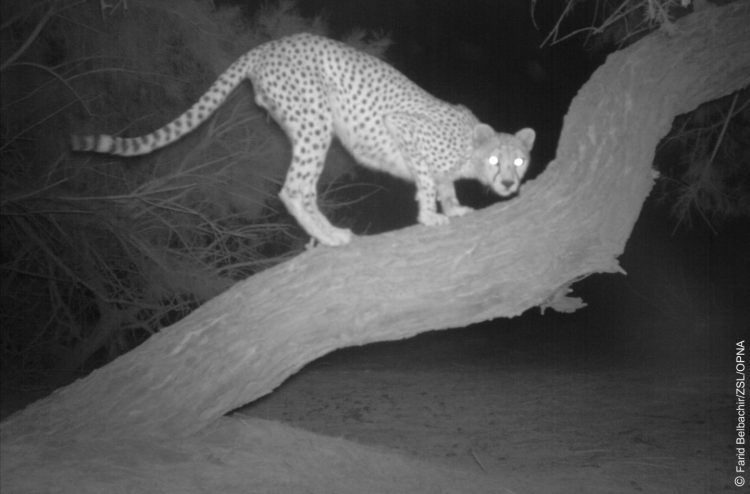A rare glimpse at the elusive saharan cheetah

Research by scientists and conservationists from the Wildlife Conservation Society, the Zoological Society of London, and other groups published today in PLOS ONE shows that critically endangered Saharan cheetahs exist at incredibly low densities and require vast areas for their conservation. The research also offers some of the world's only photographs of this elusive big cat. Credit: Farid Belbachir/ZSL/OPNA
Research by scientists and conservationists from the Wildlife Conservation Society, the Zoological Society of London, and other groups published today in PLOS ONE shows that critically endangered Saharan cheetahs exist at incredibly low densities and require vast areas for their conservation. The research also offers some of the world's only photographs of this elusive big cat.
The findings are a result of the monitoring of Saharan cheetahs, a critically endangered cheetah subspecies, in Ahaggar Cultural Park, Algeria. Remote infra-red camera traps were used and the photographs gathered have provided the world's scientific community with some of the only close-up photographs ever taken of the Saharan cheetah. There are thought to be fewer than 250 of these animals left in the Sahara, making them one of the rarest carnivores on the planet.
The findings by scientists and conservationists at WCS, ZSL, University College London, UK, and Université de Béjaïa, Algeria, in collaboration with the Office National du Parc Culturel de l'Ahaggar, show that the Saharan cheetah adapts its behavior to cope with the harsh desert environment in which it lives. They are active at night, probably to avoid heat or contact with humans, and must cover a vast amount of ground to find prey.
Research into how cheetahs survive within extreme desert conditions gives scientists a better understanding of how best to approach their conservation. The survival of large carnivores within the Sahara desert indicates that at present the Ahaggar Cultural Park is still a relatively healthy habitat; however there are threats to cheetah and their prey. Authors argue that more needs to be done to secure this habitat's long-term survival.
Farid Belbachir, lead-author from Laboratoire d'Ecologie et Environnement, Université de Béjaïa, Algeria, said: “This is the first time we have been able to collect scientific data on the rare Saharan cheetah, as in the past we have had to rely on anecdotes and guesswork. We hope that this important carnivore does not follow the path to extinction like other Algerian desert species such as the addax antelope and dama gazelle.”
Dr Sarah Durant, co-author from WCS and ZSL, added: “This research provides us with important new insights into the world of this remarkable desert-dwelling large cat. I hope that it not only provides invaluable scientific information about the ecology of the Saharan cheetah for the first time but also reminds the world of the value of studying and protecting desert species and their environments, which are often overlooked by researchers and conservation programs.”
Confined to desert environments, the Saharan cheetah lives in pockets of north and west Africa. The report shows that Saharan cheetahs are more nocturnal, more wide-ranging and occur at lower densities than other cheetahs living in Africa.
The authors are: Farid Belbachir of the Zoological Society of London, UK, University College London, UK, and Université de Béjaïa, Algeria; Sarah M Durant of the Zoological Society of London, UK, and the Wildlife Conservation Society USA; Nathalie Pettorelli of the Zoological Society of London, UK ;Tim Wacher of the Zoological Society of London, UK; and Amel Belbachir-Bazi of Universite de Bejaia, Algeria
This project was made possible through the generous support of the Howard G. Buffett Foundation, the partnership with Panthera, and others.
Study link: http://dx.
Media Contact
All latest news from the category: Ecology, The Environment and Conservation
This complex theme deals primarily with interactions between organisms and the environmental factors that impact them, but to a greater extent between individual inanimate environmental factors.
innovations-report offers informative reports and articles on topics such as climate protection, landscape conservation, ecological systems, wildlife and nature parks and ecosystem efficiency and balance.
Newest articles

High-energy-density aqueous battery based on halogen multi-electron transfer
Traditional non-aqueous lithium-ion batteries have a high energy density, but their safety is compromised due to the flammable organic electrolytes they utilize. Aqueous batteries use water as the solvent for…

First-ever combined heart pump and pig kidney transplant
…gives new hope to patient with terminal illness. Surgeons at NYU Langone Health performed the first-ever combined mechanical heart pump and gene-edited pig kidney transplant surgery in a 54-year-old woman…

Biophysics: Testing how well biomarkers work
LMU researchers have developed a method to determine how reliably target proteins can be labeled using super-resolution fluorescence microscopy. Modern microscopy techniques make it possible to examine the inner workings…





















